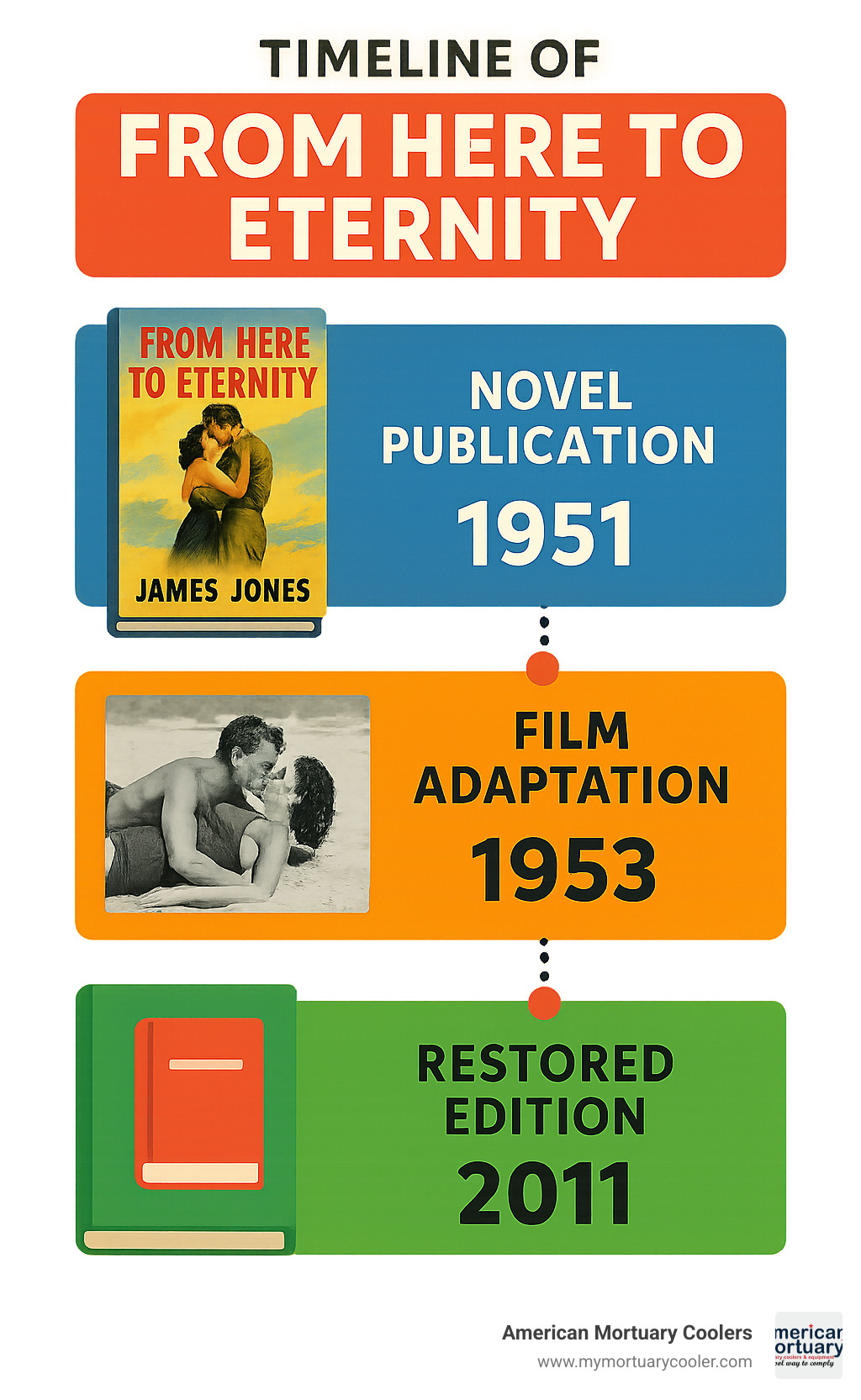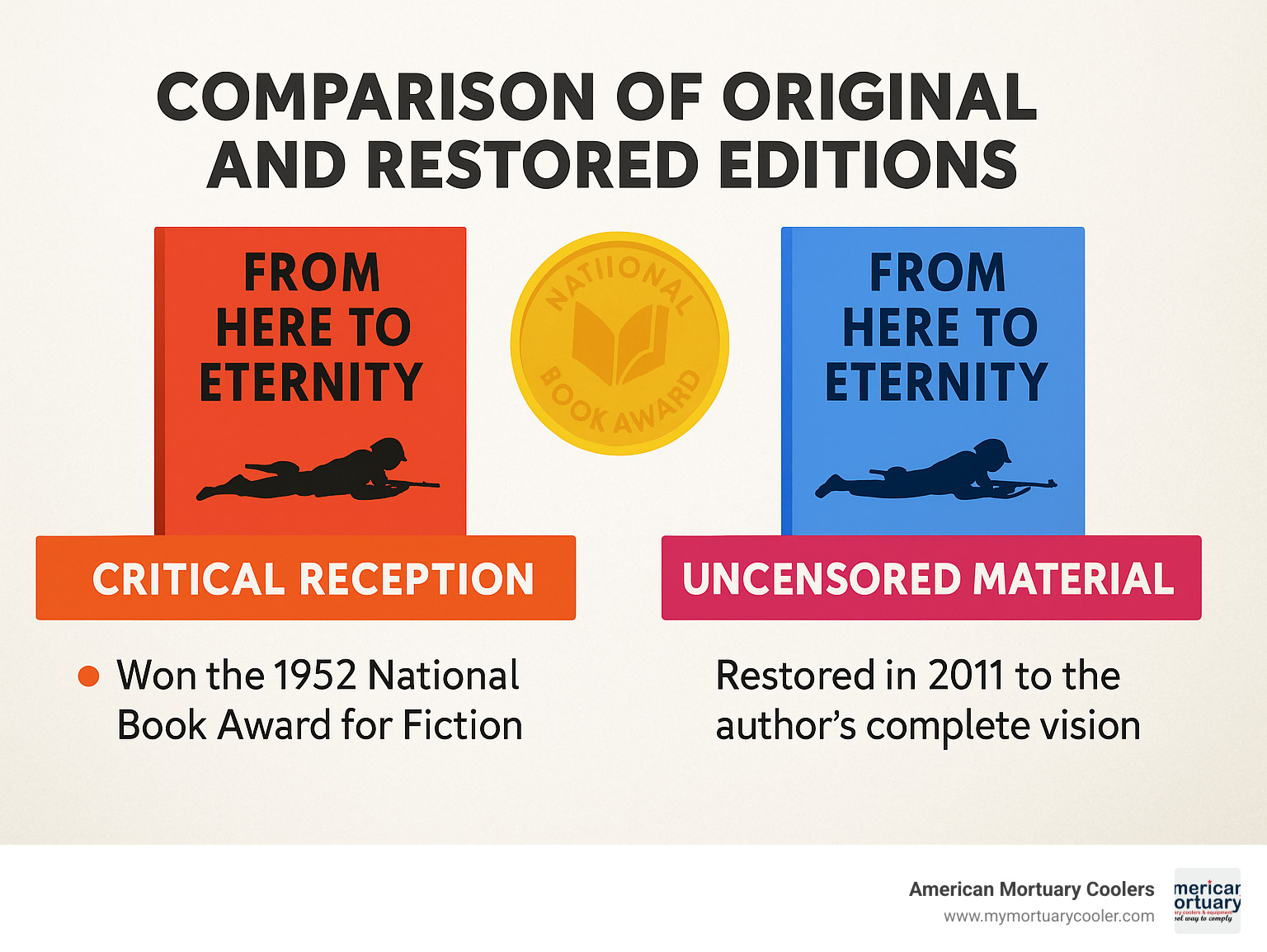Understanding a Literary Masterpiece
From Here to Eternity book is a landmark 1951 novel by American author James Jones that follows the lives of U.S. Army soldiers stationed in Hawaii in the months leading up to the Pearl Harbor attack. This 861-page debut novel won the National Book Award for Fiction in 1952 and was ranked #62 on the Modern Library's list of 100 Best Novels of the 20th century.
Quick Facts About From Here to Eternity:
- Author: James Jones
- Published: February 26, 1951
- Publisher: Charles Scribner's Sons
- Setting: Schofield Barracks, Hawaii, 1941
- Main Characters: Private Robert E. Lee Prewitt, First Sergeant Milton Warden, Captain Dana Holmes, Karen Holmes, Lorene (Alma Schmidt)
- Awards: National Book Award for Fiction (1952)
- Average Rating: 4.08/5 on Goodreads (based on over 17,800 ratings)
The novel centers on Private Prewitt, a talented boxer who refuses to join the regimental boxing team and faces brutal hazing known as "The Treatment" as a result. Meanwhile, First Sergeant Warden begins a dangerous affair with his commanding officer's wife, Karen Holmes. These personal struggles play out against the backdrop of military life just before America's entry into World War II.
What makes From Here to Eternity book remarkable is its unflinching portrayal of army life, with Jones drawing from his own military experiences to create an authentic depiction of soldier camaraderie, institutional brutality, and the complex moral codes that governed military existence. The novel was initially censored, with explicit language and gay sex passages removed; these were later restored in a 2011 edition.
While companies like Frigid Fluid, Dodge Company, and Pierce Chemical offer various mortuary supplies, at American Mortuary Coolers we focus exclusively on high-quality cooling equipment for funeral homes. Our expertise in preservation technology gives us a unique perspective on works like From Here to Eternity book that deal with mortality and dignity in challenging circumstances.

Plot & Characters of the From Here to Eternity Book
James Jones drops us straight into Schofield Barracks, 1941a pressure-cooker where boredom, pride, and looming war collide. At the center stands Private Robert E. Lee Prewitt, a gifted boxer who refuses to fight after accidentally blinding a sparring partner. His moral stand triggers "The Treatment," a sanctioned campaign of drills and humiliations ordered by Captain Dana Holmes and carried out by First Sergeant Milton Warden.
While Prew endures, Warden wages his own quiet rebellionan affair with Karen Holmes, the captains neglected wife. Their stolen moments echo Prews defiance: both challenge an institution that demands absolute conformity.
Jones weaves these plot strands with a tragic friendship (Prew & Angelo Maggio), sadistic stockade guard "Fatso" Judson, and the ever-gathering storm of Pearl Harbor. By the time the attack comes, characters weve come to know are forced to choose between self-preservation and dutydecisions that prove fatal for some.
| Book vs. Film Comparison | Novel | 1953 Film |
|---|---|---|
| Length | 861 pages | 118 minutes |
| Explicit content | Significant (more in restored edition) | Toned down |
| Ending | Prew killed by MPs | Similar, softened |
| Gay content | Present in restored text | Omitted |
| Military portrayal | Harshly critical | Moderated |
Pocket Plot Summary
- Prewitt transfers to G Company; refuses to box.
- Captain Holmes orders systematic hazing.
- Warden and Karen begin an illicit relationship.
- Maggio is brutalised in the stockade and dies after escaping.
- Prew kills Judson, hides with Lorene, then tries to rejoin his unit during Pearl Harboronly to be mistaken for an infiltrator and shot.
- Warden refuses an officers commission; Karen and Lorene each depart Hawaii alone, spinning private myths about the men they loved.
Key Characters in Brief
- Robert E. Lee Prewitt principled bugler/boxer whose refusal to compromise seals his fate.
- First Sergeant Milton Warden tough, competent, secretly yearning for a life beyond olive drab.
- Captain Dana Holmes ambitious officer more interested in boxing trophies than soldiers.
- Karen Holmes wounded spouse seeking connection and escape.
- Angelo Maggio irrepressible friend whose death pushes Prew over the edge.
- "Fatso" Judson embodiment of institutional cruelty.
- Lorene (Alma Schmidt) pragmatic hostess saving for a respectable future.
These compressed portraits still capture the novels essence: ordinary people wrestling with loyalty, love, and the machinery of war.
Themes, Title Meaning & Social Commentary
The From Here to Eternity book is far more than a military yarn; Jones uses the barracks as a laboratory for some timeless questions.
Conformity vs. Individuality
Prews refusal to box illustrates the cost of staying true to oneself when an institutions "team spirit" demands surrender.
Authority and Its Abuses
Characters like Captain Holmes and "Fatso" Judson show how a rigid chain of command can shelter ambition and sadism, a warning that extends well beyond the army.
Masculinity & Sexuality
Jones peels back barracks bravado to reveal vulnerabilityand, in the restored edition, the underground gay economy of 1941 Waikiki (see The Guardian report).
Class & Power
Uniforms may look alike, but paygrades, accents, and future prospects divide officers, enlisted men, and civilians like Lorene.
Origin of the Title
Borrowed via the Whiffenpoof Song from Kiplings line "damned from here to eternity," it hints at endless military drudgery and the life-altering weight of each choice.
By setting his story just before Pearl Harbor, Jones removes the gloss of battlefield heroism and forces us to confront the everyday grindand quiet courageof soldiers who have yet to fire a shot.
Publication, Reception & Legacy
The story behind how the From Here to Eternity book made its way into the world is almost as fascinating as the novel itself. When James Jones's manuscript landed on editors' desks at Charles Scribner's Sons in the early 1950s, they knew they had something explosive on their hands—both in literary quality and potential controversy.
Published on February 26, 1951, this 861-page debut novel immediately stirred the literary pot. But what readers held wasn't Jones's complete vision. The original manuscript underwent significant censorship before reaching the public. Explicit language was toned down, gay sex scenes involving soldiers in Waikiki were completely removed, and some of the more graphic heterosexual content was softened. These weren't minor edits—entire subplots and character motivations disappeared in the process. Jones reluctantly accepted these compromises, understanding it was the only way his work would reach readers in the conservative post-war era.
Despite these cuts, the From Here to Eternity book made an immediate and powerful impact. In 1952, it claimed the prestigious National Book Award for Fiction, launching Jones from unknown veteran to literary star. Critics couldn't stop talking about it. The Saturday Review boldly called it "a work of genius," while The New York Times described it as "a blockbuster of a book... raw and brutal and angry." Even The New Yorker joined the chorus of praise, calling it "ferocious... the most realistic and forceful novel I've read about life in the army."
The novel wasn't just a critical darling—readers couldn't get enough either. By summer 1953, before the famous film adaptation hit theaters, the From Here to Eternity book had already sold about 400,000 copies. The movie's release turned those solid sales into a genuine phenomenon, boosting weekly sales from around 500 copies to approximately 4,000. Years later, the Modern Library would rank it number 62 on its list of the 100 Best Novels of the 20th century, cementing its place in the American literary canon.

What Jones accomplished with his debut went beyond sales figures. At a time when American fiction was becoming increasingly introspective and psychological, his work boldly revived the tradition of literary naturalism pioneered by writers like Theodore Dreiser and Frank Norris. His unromantic portrayal of soldiers as complex, flawed human beings rather than simple heroes or villains set a new standard for authenticity in war literature that influences writers to this day.
Perhaps the most interesting chapter in the publication story came sixty years after the original release. In 2011, Jones's daughter Kaylie worked with editor George Hendrick to publish a digital restored edition that included all the previously censored material. For the first time, readers could experience Jones's complete vision, including his more nuanced portrayal of sexuality in the pre-war military and the underground gay subculture that existed in 1941 Hawaii. This restored edition (released in print in 2013) gives us a fascinating window into changing social attitudes toward sexuality, language, and literary freedom in America between 1951 and 2011.
The National Book Award archive still proudly displays Jones's achievement, while the Guardian's report on the restored text offers fascinating insights into what was cut and why.

While competitors like Mortech Manufacturing and Mopec focus on autopsy equipment and broader mortuary supplies, American Mortuary Coolers specializes exclusively in high-quality cooling systems for funeral homes. This specialization mirrors Jones's focused examination of military life—both require attention to detail and respect for human dignity in challenging circumstances.
Adaptations & Cultural Impact
The From Here to Eternity book has enjoyed a remarkable journey beyond its printed pages, inspiring adaptations that have both preserved and reimagined Jones's powerful story for new generations.
The 1953 Film Adaptation
The most celebrated adaptation remains the 1953 film directed by Fred Zinnemann. Starring Burt Lancaster as Warden, Montgomery Clift as Prewitt, Deborah Kerr as Karen, Donna Reed as Lorene, and Frank Sinatra as Maggio, this version became a cultural phenomenon in its own right. The film swept the Academy Awards, claiming 8 Oscars including Best Picture, Best Director, and supporting acting awards for both Sinatra and Reed.
Of course, bringing Jones's raw, unfiltered novel to 1950s moviegoers required significant changes. The film's producers had to steer the strict Production Code of the era, which meant toning down the novel's explicit language and sexual content. The gay content was completely removed, the military's harsh treatment of soldiers was somewhat softened, and the ending received slight modifications to be less bleak.
Despite these necessary compromises, the film managed to capture the emotional core of Jones's work. And it gave us one of cinema's most unforgettable moments – the passionate beach scene between Lancaster and Kerr, with waves crashing over their embracing bodies. This scene has become so iconic that even people who've never seen the film or read the From Here to Eternity book recognize it as a cultural touchstone.

Television Adaptations
The story found new life on television through two separate adaptations:
A 1979 NBC miniseries starring Natalie Wood, William Devane, and Steve Railsback took advantage of the longer format to explore more of the novel's complexity than the film could accommodate. The extra runtime allowed for deeper character development and inclusion of subplots that the movie had to trim.
Just a year later, ABC launched a television series that attempted to continue the story beyond the novel's conclusion. Despite an intriguing premise, the show failed to connect with audiences and was canceled after just 13 episodes.
While neither television version achieved the cultural impact of the 1953 film, they helped introduce Jones's story to new generations of viewers.
Stage Adaptation
In 2013, legendary lyricist Tim Rice brought From Here to Eternity to London's West End as a musical. This adaptation made a deliberate effort to restore some of the grittier elements from Jones's novel that had been missing from the film version. Though critical reception was mixed, the musical demonstrated the enduring power of the story to resonate across different media and generations.
Cultural Legacy
Beyond formal adaptations, the From Here to Eternity book has left an indelible mark on our cultural landscape:
The title itself has become a widely recognized phrase, often used in contexts completely unrelated to the novel. The beach scene from the film is constantly referenced, homaged, and parodied in movies, television shows, and advertisements.
Jones's unflinching portrayal of military life created a template that influenced countless later films and novels about the armed forces. Before "From Here to Eternity," many depictions of military life were sanitized or glorified. After Jones's work, creators felt empowered to show the complexities and contradictions of service life.
The novel also helped shape America's perception of Hawaii, adding layers of complexity to what many mainland Americans had previously viewed as simply an exotic paradise.
In military literature, Jones's work stands as a cornerstone. His trilogy of war novels (completed by "The Thin Red Line" and "Whistle") represents one of the most significant literary examinations of World War II and its impact on American servicemen.
The publication of the restored 2011 edition has sparked renewed scholarly interest in Jones's achievement. Literary critics are now examining his groundbreaking treatment of sexuality and masculinity in military contexts with fresh eyes. This has led to a deeper appreciation of the novel's pioneering qualities and its continued relevance to contemporary discussions about gender, sexuality, and power within institutional settings.
While companies like Thermo Fisher Scientific and Darwin Chambers offer laboratory refrigeration, American Mortuary Coolers provides specialized cooling solutions designed specifically for funeral homes. Our focus on dignity in death care parallels Jones's concern with preserving human dignity within dehumanizing institutions.
Frequently Asked Questions about From Here to Eternity
Why did the novel cause such a stir in 1951?
Even after heavy edits, readers faced salty language, frank sex, and an unpatriotic portrait of pre-war army life. Many civilians were shocked; many veterans nodded in recognition.
How true is it?
Jones served at Schofield Barracks and fought in WWII. Soldiers who knew him said the book captured "80–90 %" of what they livedfrom boxing obsessions to stockade brutality.
What changed in the 2011 restored edition?
Roughly four pages return: soldiers hustling in Waikikis gay underground, rawer dialogue, and fuller sex scenes. Small in length, huge in nuance.
For more on funeral-industry history (our day job at American Mortuary Coolers) see this overview.
Conclusion
From Here to Eternity book remains one of the most powerful and honest American novels of the 20th century. James Jones created something truly special – a story that works as both riveting drama and unflinching social commentary while preserving a crucial moment in American history.
What makes this novel stick with readers across generations is its raw truth about human nature. Jones refused to paint simple black-and-white pictures of heroes and villains. Instead, he showed us how good people can be corrupted by broken systems, how cruelty and kindness can live in the same heart, and how standing by your principles often comes at a terrible price.
The book's journey mirrors America's own evolution. First published with significant censorship in 1951, then finally restored to its complete vision in 2011, the novel reflects how our society's attitudes toward language, sexuality, and military mythology have transformed over time. Each new generation finds something relevant in its pages – whether during the conformist 1950s, the rebellious 1960s, or today's conversations about masculinity and institutional power.
For readers finding the book today, I strongly recommend picking up the restored edition. Those additional passages aren't just extras – they provide essential context about the economic and sexual realities of military life in pre-war Hawaii that deepen the entire story.
At American Mortuary Coolers, we find ourselves drawn to the novel's unflinching look at mortality and its insistence on preserving human dignity even in the harshest circumstances. While competitors like Mortech and Mopec offer broader mortuary supplies, our focus on high-quality cooling systems reflects our specialized commitment to dignity in death care.
The From Here to Eternity book reminds us that every life contains its own complete story – filled with struggles, loves, principles and compromises. Whether in great literature or in our work providing quality mortuary equipment across Tennessee and beyond, honoring those stories with honesty and dignity remains at the heart of what matters most.
For those interested in learning more about our services at American Mortuary Coolers, please visit our website or contact our teams in Johnson City, Atlanta, Chicago, or any of our regional offices. While we primarily serve funeral homes and medical facilities, we share with James Jones a commitment to treating life's most difficult realities with respect and unflinching honesty.



















